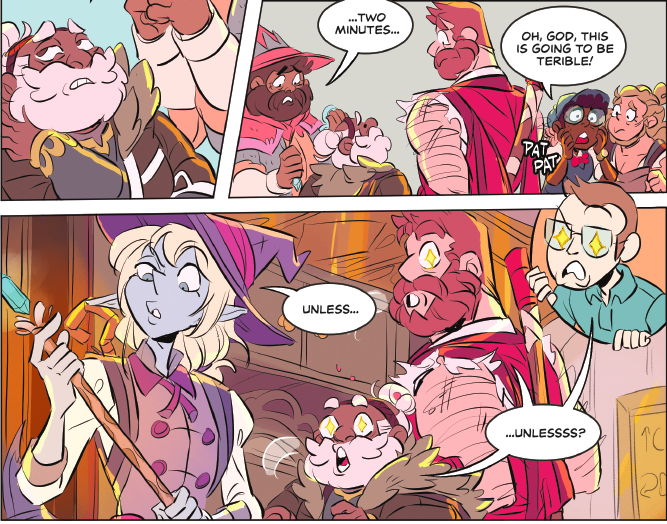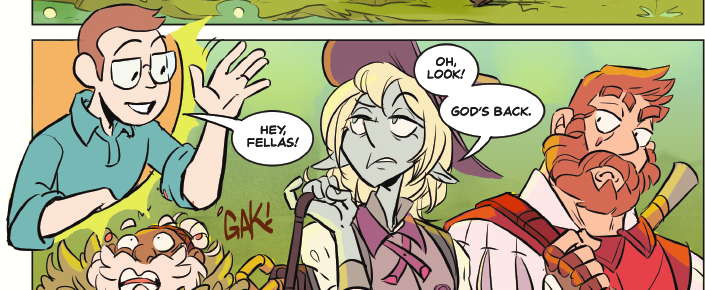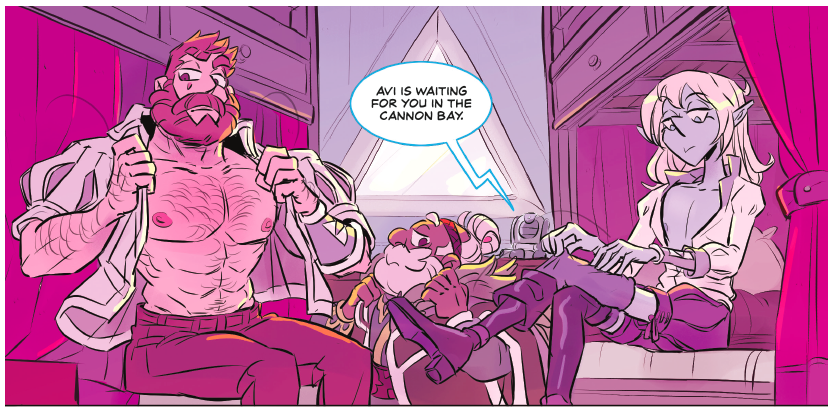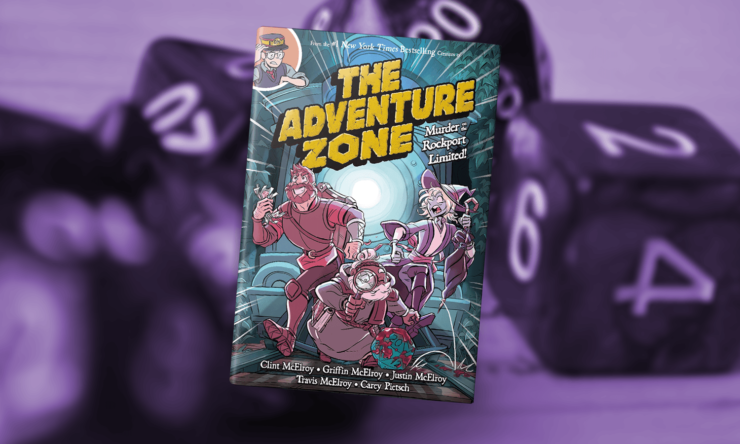The Adventure Zone returns this week with capers, magical items, and goofs galore. In the second volume of the series, we find Magnus, Taako, and Merle in a mystical world of exposition, followed up by an epic murder mystery slash train heist to retrieve a dangerous artifact. As always, though, it’s the comedic beats and the characters that drive the engine on this particular train. From the introduction of beloved podcast characters like Garfield the Deals Warlock and Boy Detective Angus McDonald, to the virtual demolishment of the fourth wall, Murder on the Rockport Limited delivers on every possible expectation. Fans of the original podcast will not be disappointed; in fact, if they’re like me, they will make embarrassing whoop-ing sounds while reading it in public.
All of this is to say that the McElroys still got it. But the real star here is artist Carey Pietsch.
[And Angus McDonald, obviously.]
In my review of Here There Be Gerblins last year, I waxed poetic about the collaborative nature of podcasts, RPGs, and comics, and not a single one of those feelings have lessened with this second volume. It is refreshing and exciting to explore a world that is being built from the ground-up by a team of witty, amiable creators. Of course, it’s impossible not to talk about the divergences between the original and the adaptation (and I’ll get to that later), but this time I mostly want to talk about the ways that Pietsch explores the story visually. Humor and gameplay are all carried out with aplomb, and character beats—as much a benefit of the visual medium as of the fact that the story is no longer being created in real-time—are plentiful and lovely.

The McElroy brand of humor is a difficult thing to pinpoint, being as it’s simultaneously sharp and gentle, referential and original. It’s dynamic, and silly, and god does describing comedy just make me feel frightfully inadequate as a writer. I can only imagine the difficulties of adapting it. The TAZ graphic novels don’t try to illustrate jokes verbatim—how could they?—instead using a slew of visual cues: recurring title cards, little notes in unexpected places, facial expressions and body language, and ongoing self-commentary. Character movement is anything but economical—they throw themselves onto nearby surfaces, wave their arms around, slouch and hover, making them feel simultaneously over-the-top and true-to-life. Rockport Limited even features little visual easter egg jokes for fans of other McElroy properties (Paul Blart! Shrimp Heaven Now! And—my favorite—an invocation of the “unless” choral arrangement). The overall effect of all these hidden gems is that you as a reader feel like you’re in on the joke, which is a perfect tone to set for a story that relies so heavily on breaking its own form.
The primary way that TAZ breaks its own form is of course through the mechanics of Dungeons & Dragons gameplay. Leveling up, gaining special items, and arguing with the DM all call attention to not only the characters-as-creators, but also the inherent silliness of most epic quest stories. “Oh look,” Taako says at one point, when Griffin floats into view, gearing up to push the plot into motion, “God’s back.” In addition to this constant fourth-wall smooshing, Taako, Merle, and Magnus often break form by laughing at their own and each other’s jokes. This not only brings out the feelings of delight and surprise of the original podcast, but also makes the whole thing rather more authentic than many other mainstream comics. Who cracks a joke without smiling? Batman, for one. But not Magnus Burnsides.

Pietsch’s art and the McElroys’ updated storytelling don’t just lend themselves to humor and game mechanics—Rockport Limited contains some wonderful character development as well. In one scene towards the end, we find Taako in a moment of quiet introspection, staring into the night sky and smiling at his friends’ hijinks. In another, the Director breaks down after the boys have left the room, slamming her fists to the table in some combination of grief and defeat. These moments, mostly devoid of dialogue, could not have existed in the podcast, not only because of their exclusively visual nature, but also because they exist outside of the story’s main narrative. We’re not following a marauding band of misfit RPG adventurers in these scenes, but looking at fully-realized lives. The scenes foreshadow what’s to come, and are quite poignant. They are a more-than-welcome addition to a story I already love.
There are, of course, some more immediate editorial changes afoot: battles are edited for time, Tom Bodett’s cameo is made a pinch subtler (I can’t imagine why), and characters and plot threads are introduced long before they’re relevant to the story. Taako even shows a level of intelligence and suspicion of the Bureau that was relegated to much later chapters of the podcast. All of these changes are clever and necessary, both to update the text and to make it more accessible to new audiences. Beyond just enjoying Rockport Limited on a visceral level (my notes include a list of all the ways that Angus McDonald is perfect), I was just impressed by it. It’s not so much that it improves on the original, but that Pietsch and the McElroys have let it become its own living, breathing thing. It’s heartwarming and it’s whip smart and it’s fun as hell. The gratuitous shirtlessness doesn’t hurt.

Buy the Book


The Adventure Zone: Murder on the Rockport Limited
Em Nordling reads, writes, and manages research in Louisville, KY.











I can’t wait to pick this up. I’m almost finished listening to the ‘Balance’ story on TAZ for a second time. I hope they do the whole thing as it’s a fantastic story.